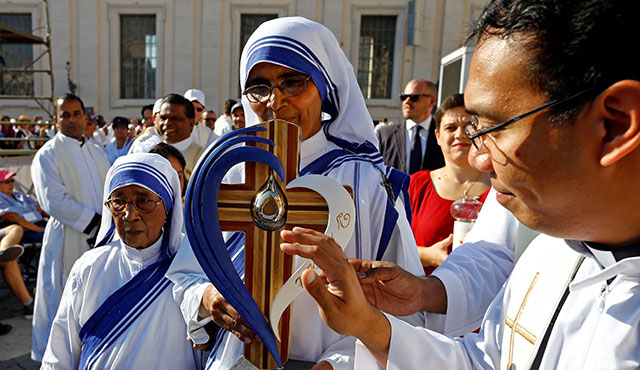We all understand that if we live long enough on this earthly plane, we’ll eventually lose someone we love. Like death itself, going through the passing of a good friend, family member or fellow parishioner is inevitable. Keeping something once held dear by the departed – a box of old letters, a piece of jewelry or a favorite collectible, for example – helps us remember what life was like when they were alive.
This applies in the historical context as well: The USS Arizona will always tie Americans with those who gave their lives during the 1941 attack on Pearl Harbor. The Ford’s Theatre Museum displays the bloodstained pillow on which Abe Lincoln died. It’s the same with Catholicism.
For centuries, Catholics have saved relics that forever connect their present-day faith with the saints who are united with Christ. The items in question are, more often than not, body parts. While to some this may seem morbid, or just plain odd, stop for a moment and picture the remains of Uncle Phil sitting on your mantel. You love and honor the him every time you cruise by and glance at his ashes.
With few exceptions, relics in the form of the saints’ body parts (bones, hair, a limb and so forth) hold greater importance than the objects associated with them. Body parts are designated first-class relics, those held in the greatest esteem. Others include items directly associated with Christ and the events in His life. The Church designates second-class relics as items that were important in a saint’s life, such as a crucifix, Bible, rosary, item of clothing or even something he or she touched. And third-class relics are comprised of objects that touched first- or second-class relics.
Some of the most prominent Catholic relics include the bones of St. Peter, the body of St. Mark, the mummified head of St. Catherine of Siena and the finger of St. Thomas. The Shroud of Turin is perhaps the Catholic Church’s most-famous first-class relic. Bearing the image of Jesus, it is considered to be His burial shroud.
Catholics throughout the world pray before religious relics. This is discouraged. Instead, the faithful should keep the meaning of all relics in perspective. In his Letter to Riparius, St. Jerome wrote, “We do not worship, we do not adore, for fear that we should bow down to the creature rather than to the Creator, but we venerate the relics … in order the better to adore Him whose martyrs they are.”
Reliquaries are the containers that protect and display some, but not all, relics. They vary in shape and size, and many were covered with silver, gold and gems.
“We have two reliquaries of Father [Junipero] Serra,” says Msgr. Stephen Doktorczyk, vicar general of the Diocese of Orange. “They were gifted by the family of a deceased man who had obtained them.”
Msgr. Doktorczyk notes that when a church is formally dedicated, the bishop of that church’s diocese writes the Diocese of Rome to request a relic. “This was done for Holy Trinity, in South County. We wrote to the office in Rome, and relics were sent.”
Rome isn’t the only place that provides relics. “The bishop may write to the headquarters of a religious institute if the relics requested concern a saint who belonged to a particular religious institute while living,” says Msgr. Doktorczyk. “With more and more saints being named from outside of Italy, it’s more likely a bishop who wants a non-Roman saint would go outside of a Roman office to obtain such a relic.
“Once a relic is received, it is embedded in the dedicated church’s altar.”
Unfortunately, fake relics are sold every day, online and at such venues as flea markets. Some buyers want to believe in the authenticity of a relic, and they act on impulse. They should know that the Code of Canon Law #1190 states that, “It is absolutely forbidden to sell sacred relics.” That noted, those who would do so for profit simply cannot be trusted.
How can diocese officials know whether or not the relic they receive is real? Those that originate from the Vatican (or from the headquarters of a religious institute in its country of origin) must be sent with a certificate of authenticity signed by an approved Church official. To some extent, it boils down to common sense: An “authentic” relic available on eBay probably isn’t.
A pragmatist, cynical or otherwise, may argue that a sacred relic’s authenticity needn’t even be an issue. Sacred or fake, the object in question points to all that is divine. No relic is, or has ever been, divine, but faith ultimately leads the believer to its holy source.
St. Augustine put it another way: “For even now miracles are wrought in the name of Christ, whether by His sacraments or by the prayers or relics of His saints.”


